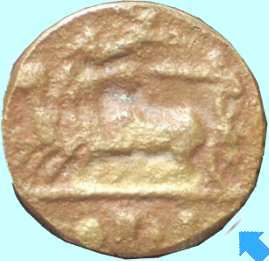|
Roma, 26.3.2012
Egregio
Lettore,
non dispongo a casa di manuali per la monetazione
greca che non rientra nell'area di mio
approfondimento. Tuttavia, allo scopo di soddisfare
almeno in parte l'esigenza rappresentata e nei limiti
di quanto dianzi affermato, di seguito le comunico gli
elementi significativi pertinenti alla/e moneta/e che
mi è stato possibile raccogliere dopo una ricerca nel
web:
Decadrammo1,
Zecca di Siracusa, c. 405 a. C.
Descrizione sommaria:
D. Quadriga al galoppo a sinistra, Nike in volo a
destra incorona un auriga. Sotto la linea di esergo,
scudo, schinieri, corazza ed elmo attico.
R. Testa di Arethusa a sinistra, attorno, appena
abbozzati, quattro delfini.
Dalla ricerca nel web ho ricavato i link che
seguono, i primi tre attinenti a decadrammi
autentici, tipologicamente affini alla moneta in
esame; gli ultimi tre attinenti a riproduzioni
moderne degli stessi tipi:
- http://www.acsearch.info/search.html?search=similar%3A31065
A remarkable selection of Greek Coins
Syracuse Decadrachm signed by Euainetos circa 400,
AR 42.44 g. Fast quadriga driven l. by...
- http://www.britishmuseum.org/explore/highlights/highlight_image.aspx?image=k130576.jpg&retpage=17506
Greek, around 413 BC From Syracuse, Sicily A
Sicilian-Greek coin signed by the artist. Among
the finest of all Sicilian coins are those of the
city of Syracuse. The people of Syracuse were
Greek, and they followed the East Greek coinage
tradition. Some of the artists of Syracuse took
great pride in the dies that they cut, and
engraved them with their own names or initials.
Among several known masters was one called Kimon.
The first two letters of his name (KI) can be seen
engraved on the headband of Arethusa on the
reverse of his coins. On the obverse (front) of
this coin a man is shown driving a four horse
racing-chariot (quadriga) and being crowned by
Nike, the goddess of Victory. Beneath this scene
is depicted a panoply of armour, with the word
ATHLA ('prizes' or 'spoils') engraved above it.
These coins have often been interpreted as
presentation pieces struck in commemoration of the
Syracusan victory over the Athenians in the
Peloponnesian War in 413 BC. Weight: 43.360 g
Diameter: 35.000 mm CM BMC Syracuse 201.
- http://www.coinarchives.com/a/results.php?search=decadrachm+Syracuse&s=0&results=100
...
- http://tjbuggey.ancients.info/images/syrdek.jpg
Syracuse. Circa 405-400 BC. AR Dekadrachm (24.62
gm) Obv: Charioteer driving galloping quadriga
left, holding kentron in right hand, reins in
left; Nike flying above and crowning charioteer;
below heavy exergual line: a military harness,
shield, greaves, cuirass and Attic helmet all
connected by a horizontal spear. Rx: Wreathed head
of Arethusa left, wearing triple-pendant earring
and necklace, four dolphins swimming around; shell
behind. Yeah, well I wish. This is one of two fake
coins in my collection. Hand struck with dies cast
from originals, but not silver and not very old.
still it is nice to look at.
- http://www.forumancientcoins.com/fakes/displayimage.php?pos=-8495
Fake Syracuse, Decadrachm, Kimon Obv:- ΣYPAKOΣIΩN,
head of Arethusa left, wearing earring, necklace,
and band tied above, and net; on front of bank, KI
M; four dolphins around Rev:- Quadriga left;
above, Nike flying right, about to crown
charioteer; horses in high action; in exe, a ledge
or step, on and against which is placed a suit of
armour, border of dots Fig 1a is the false coin -
42.83g. available cleaned (like this) and
uncleaned.
- http://www.forumancientcoins.com/fakes/displayimage.php?pos=-368
Syracuse, silver dekadrachm, 175 AR dekadrachm, by
Euainetos ΣY PAK O ΣI ΩN, head of Persephone left,
wearing earring and necklace; hair turned up
behind, arranged in wavy curls, and bound with
wreath of corn leaves; four dolphins around;
traces of EY AINE: border of dots / Qaudriga left;
above, Nike flying right, about to crown
charioteer; horses in high action; in exg, a ledge
or step, on and against which is placed a suit of
armour: border of dots BMC Sicily 175 405-400BC.
Chariot reverse. Sold on Ebay as a hand made copy,
no two alike. No identification as copy anywhere
on coin.
Veniamo alle conclusioni: si è già osservato nella nota 1 che la pecca più evidente
della moneta di figura e delle sue 14 consorelle è la
lega utilizzata per la fabbricazione, non l'argento ma
il rame (la monetazione in rame di Siracusa non
utilizza, come tipo del dritto, la quadriga). Mi pare
opportuno aggiungere e rilevare la pessima qualità
delle riproduzioni, solo a confrontarle con le monete,
anch'esse non autentiche, reperite nel web di cui ai
link 4, 5
e 6. La prima impressione che si
ricava è che le 15 monete siano state prodotte in
serie, in maniera assai approssimativa, utilizzando lo
stesso stampo, limate ai bordi per eliminare le
rugosità e trattate con l'acido per simulare
l'invecchiamento; dunque autentiche patacche, da
vendere ai turisti a coronamento di un tour
archeologico in Tunisia.
Giulio De Florio
----------
(1) Decadrammo.
Il decadrammo di Siracusa si distinge dal
tetradrammo (entrambi battuti su tondello
d'argento, con quadriga sul dritto/Arethusa sul
rovescio), oltre che per il peso (c. 43g il
decadrammo, c. 17g il tetradrammo) per la
presenza, sotto la linea di esergo, di finimenti
militari (scudo, schinieri, corazza e elmo
attico). Nelle monete in esame i tipi rimandano
alla monetazione d'argento di Siracusa e la
presenza dei finimenti, appena abbozzati,
tuttavia, abbastanza distinguibili nel numero se
non nella forma, indica nel decadramma di Siracusa
la fonte di ispirazione. Se ne deduce che le
monete in esame sono riproduzioni in rame di un
decadramma di Siracusa.
|



